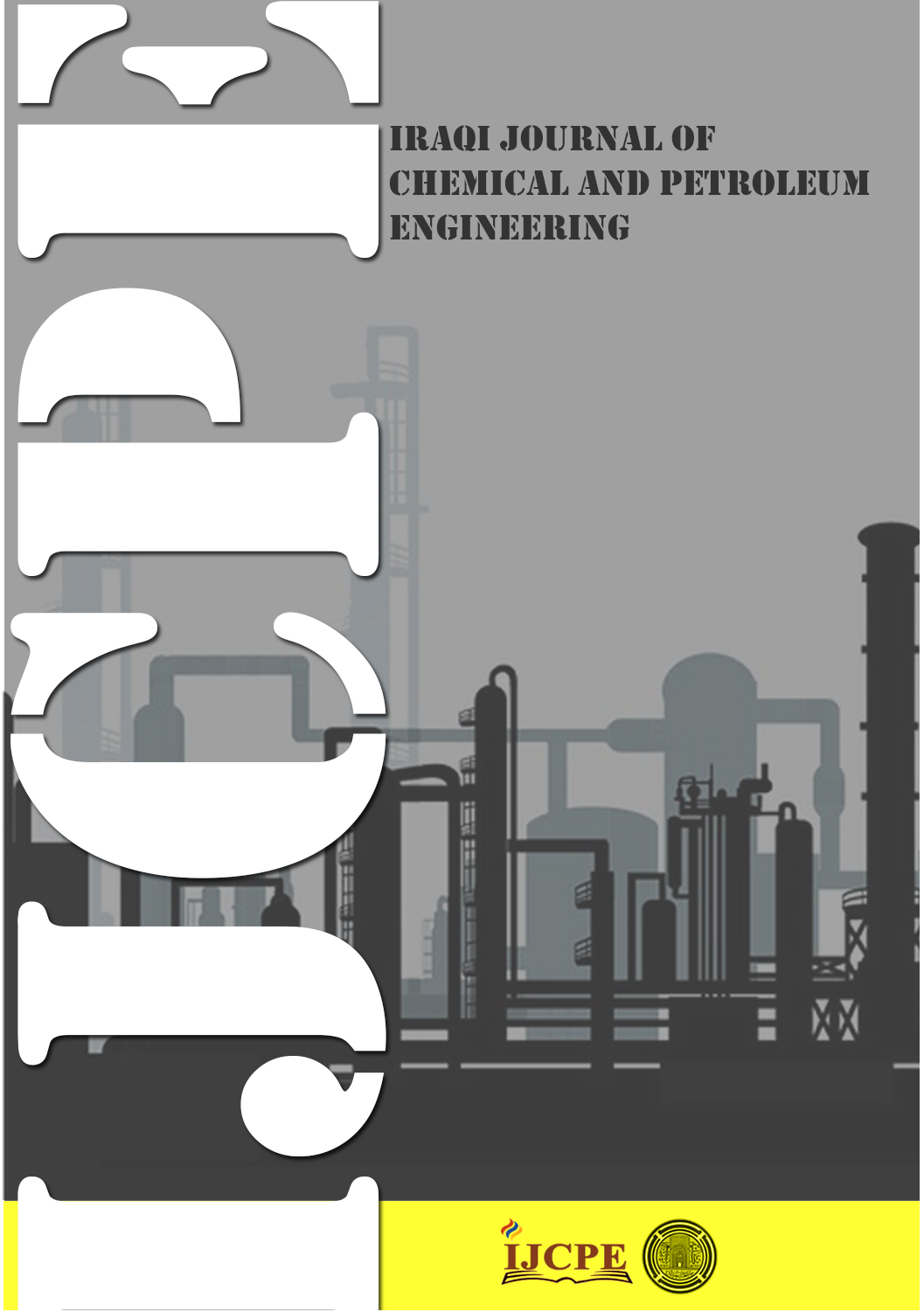Preparation and characterization of adsorptive carbonized corncob for elimination of sulfur from sulfurized n-hexane
DOI:
https://doi.org/10.31699/IJCPE.2025.2.5Keywords:
Corncob; Adsorption desulfurization; Sulfur removal; Sulfurized n-hexane; Light-cut productsAbstract
The present study is conducted to investigate the adsorption desulfurization process for eliminating sulfur from a simulated fuel within a sulfur content range similar to what exists in typical naphtha streams. The model oil, n-hexane, was sulfurized with dibenzothiophene (DBT), which is the most complex form of sulfur constituents in fuels. Corncob, a natural biomass waste material, was utilized to accomplish the adsorption remedy of sulfur.
The carbonization process took place at 500 °C. FTIR, SEM, XRD, AFM, and BET-surface area facilitated a comprehensive characterization of carbonized corncob (CC) adsorbent. The results showed that the corncob sample has homogeneous surfaces and relatively analogous active positions. The CC adsorbent was utilized to adsorb sulfur in its DBT configuration from the sulfurized fuel (n-hexane). Certain adsorption factors of temperature, contacting time, and adsorbent dosage were examined to select the most appropriate adsorption conditions. After that, the chosen conditions were employed to adsorb various sulfur concentrations. For the same initial concentration of sulfur of 400 ppm, the removal attained 75% at favorable parameters of 60°C, 30 min, and 3g L-1, respectively. The efficiency of sulfur removal was substantially augmented with the reduction of the initial sulfur content. Thus, it attained more than 79 % when the original concentration of sulfur in the n-hexane was maintained in the range of 100 ppm. The results perfectly coincided with the Langmuir model of adsorption isotherms. The thermodynamics of the desulfurization adsorption process reflected that the adsorption is associated with an endothermic event. The estimated standard enthalpy changes were 6.34 kJ mol-1. The adsorption was spontaneous over the employed temperature range of 30 – 60°C.
Received on 05/09/2024
Received in Revised Form on 29/11/2024
Accepted on 29/11/2024
Published on 30/06/2025
References
[1] A. Qasim, H. H. Alwan,"Enhancement of light Naphtha quality using calcite adsorbent from eggshells by adsorptive desulfurization", South African Journal of Chemical Engineering, Volume 46, 196-204, 2023. https://doi.org/10.1016/j.sajce.2023.08.007
[2] I. V. Babich, J. A. Moulijn, "Science and technology of novel processes for deep desulfurization of oil refinery streams: a review," Fuel, Volume 82, 607-631, 2003. https://doi.org/10.1016/S0016-2361(02)00324-1
[3] A.T. Nawaf, B. A. Abdulmajeed, “Design of oscillatory helical baffled reactor and dual functional mesoporous catalyst for oxidative desulfurization of real diesel fuel”, Chemical Engineering Research and Design, Vol. 209, pp.193-209, 2024. https://doi.org/10.1016/j.cherd.2024.07.032
[4] I. Mohammed, H. H. Alwan, A. N. Ghanim, "Using Box-Behnken experimental design for optimization of gas oil desulfurization by electrochemical oxidation technique," IOP Conference Series: Materials Science and Engineering, Volume 928, 2nd International Scientific Conference of Al-Ayen University (ISCAU-2020), 15-16 July 2020, Thi-Qar, Iraq, 022158, 2020. http://doi.org/10.1088/1757-899X/928/2/022158
[5] A. Qasim and H. H. Alwan, “Adsorptive Desulfurization of Iraqi Light Naphtha Using Calcite and Modified Calcite”, Iraqi Journal of Chemical and Petroleum Engineering, 25(1), pp. 83–93, 2024, https://doi.org/10.31699/IJCPE.2024.1.8
[6] S. M. Al-Jubouri, H. A. Al-Jendeel, S. A. Rashid, S. Al-Batty, "Green synthesis of porous carbon cross-linked Y zeolite nanocrystals material and its performance for adsorptive removal of a methyl violet dye from water," Microporous and Mesoporous Materials, Volume 356, 112587, 2023. https://doi.org/10.1016/j.micromeso.2023.112587
[7] Y. Oday, H. A. Aljendeel, "Synthesis and Characterization of Acidic Activated Carbon from Corncobs for Adsorption Desulfurization of Simulated Crude Oil," Journal of Ecological Engineering, Volume 25, Issue 8, 2024. https://doi.org/10.12911/22998993/189895
[8] M. O. Azeez, S. A. Ganiyu, "Review of biomass derived-activated carbon for production of clean fuels by adsorptive desulfurization: Insights into processes, modifications, properties, and performances," Arabian Journal of Chemistry, 105182, 2023. https://doi.org/10.1016/j.arabjc.2023.105182
[9] P. González-García, "Activated carbon from lignocellulosics precursors: A review of the synthesis methods, characterization techniques, and applications," Renewable and Sustainable Energy Reviews, Volume 82, 1393-1414, 2018. https://doi.org/10.1016/j.rser.2017.06.118
[10] X. He, X. Chen, X. Wang, L. Jiang, "Optimization of activated carbon production from corn cob using response surface methodology," Frontiers in Environmental Science, Volume 11, 1105408, 2023. https://doi.org/10.3389/fenvs.2023.1105408
[11] S. Fauzia, H. Aziz, D. Dahlan, R. Zein, "Study of equilibrium, kinetic, and thermodynamics for removal of Pb (II) in aqueous solution using Sago bark (Metroxylon sago)," AIP Conference Proceedings, Volume 2023, Issue 1, October 2018. https://doi.org/10.1063/1.5064078
[12] S. A. Obaid, "Langmuir, Freundlich, and Tamkin adsorption isotherms and kinetics for the removal of artichoke tournefortii straw from agricultural waste," Journal of Physics: Conference Series, Volume 1664, Issue 1, p. 012011, November 2020. https://doi.org/10.1088/1742-6596/1664/1/012011
[13] N. Muttil, S. Jagadeesan, A. Chanda, M. Duke, S. K. Singh, "Production, types, and applications of activated carbon derived from waste tires: an overview," Applied Sciences, Volume 13, Issue 1, 257, 2023. https://doi.org/10.3390/app13010257
[14] G. K. Jabaar, H. A. Al-Jendeel, and Y. A. Alsheikh, “Desulphurization of Simulated Oil Using SAPO-11 with CNT’s as Adsorbent: A Kinetic Study”, IJCPE, vol. 24, no. 3, pp. 69–77, Sep. 2023. https://doi.org/10.31699/IJCPE.2023.3.7
[15] A. C. Lua, T. Yang, "Effect of activation temperature on the textural and chemical properties of potassium hydroxide activated carbon prepared from the pistachio-nut shell," Journal of Colloid and Interface Science, Volume 274, Issue 2, 594-601, 2004. https://doi.org/10.1016/j.jcis.2004.02.051
[16] S. H. Ammar & S. A. Jaafar “adsorption kinetic and isotherms studies of thiophene removal from Model Fuel on activated carbon supported copper oxide”. Iraqi journal of chemical and petroleum engineering vol.18 no.2, pp. 83-93, 2017. https://doi.org/10.31699/IJCPE.2017.2.7
[17] N. M. Abdullah, H. Q. Hussien, and R. R. Jalil . “heavy naphtha desulfurization by ozone generated via the DBD plasma reactor” Iraqi Journal of Chemical and Petroleum Engineering, vol.25 no. 2 pp.131-137, 2024. https://doi.org/10.31699/IJCPE.2024.2.12
[18] C. Song, "An overview of new approaches to deep desulfurization for ultra-clean gasoline, diesel fuel, and jet fuel," Catalysis Today, Volume 86, Issues 1-4, 211-263, 2003. https://doi.org/10.1016/S0920-5861(03)00412-7
[19] G. K. Jabaar, H. A. Al-Jendeel, Y. A. Alsheikh, "Desulphurization of Simulated Oil Using SAPO-11 with CNT's as Adsorbent: A Kinetic Study," Iraqi Journal of Chemical and Petroleum Engineering, Volume 24, Issue 3, 69-77, 2023. https://doi.org/10.31699/IJCPE.2023.3.7
[20] M. H. K. Darvanjooghi, M. N. Esfahany, S. H. Esmaeili-Faraj, "Investigation of the effects of nanoparticle size on CO2 absorption by silica-water nanofluid," Separation and Purification Technology, Volume 195, 208-215, 2018. https://doi.org/10.1016/j.seppur.2017.11.032
[21] N. Gaur, K. Narasimhulu, Y. PydiSetty, "Recent advances in the bio-remediation of persistent organic pollutants and its effect on the environment," Journal of Cleaner Production, Volume 198, 1602-1631, 2018. https://doi.org/10.1016/j.jclepro.2018.07.124
[22] T. F. Akinhanmi, E. A. Ofudje, A. I. Adeogun, P. Aina, I. M. Joseph, "Orange peel as a low-cost adsorbent in the elimination of Cd (II) ion: kinetics, isotherm, thermodynamic and optimization evaluations," Bioresources and Bioprocessing, Volume 7, 1-16, 2020. https://doi.org/10.1186/s40643-020-00320-y
[23] H. Aljendeel, E. Borhan, and M. J. Al-Ani, “Kinetic Study of Transesterification Reaction of Edible Oil Using Heterogenous Catalyst”, Iraqi Journal of Chemical and Petroleum Engineering, vol. 23, no. 3, pp. 11–16, Sep. 2022, http://doi.org/10.31699/IJCPE.2022.3.2
[24] M. H. Alhassani, S. M. Al-Jubouri, H. A. Al-Jendeel, "Stabilization of phenol trapped by agricultural waste: a study of the influence of ambient temperature on the adsorbed phenol," Desalination and Water Treatment, Volume 187, 266-276, 2020. https://doi.org/10.5004/dwt.2020.26398
[25] H. A. Al-Jendeel, H. A. Rasheed, N. S. Ahmedzeki, M. H. Alhassani, "Dual Application of Al-Kheriat of Removal of Arsenic from Aqueous Solution and Acting as Rodenticide," Journal of Ecological Engineering, Volume 24, Issue 4, 2023. https://doi.org/10.12911/22998993/159335
[26] M. S. Jabbar and R. T. A. Alrubaye, “Adsorption Isotherms and Isosteric Heat of Adsorption of Metal Organic Frameworks as Gas Storage for Liquefied Petroleum Gas Vehicle in Iraq”, Iraqi Journal of Chemical and Petroleum Engineering,, vol. 23, no. 3, pp. 25–34, Sep. 2022, https://doi.org/10.31699/IJCPE.2022.3.4
[27] S. M. Al-Jubouri, et al., "Antibiotics adsorption from contaminated water by composites of ZSM-5 zeolite nanocrystals coated carbon," Journal of Water Process Engineering, Volume 47, 102745, 2022. https://doi.org/10.1016/j.jwpe.2022.102745
[28] M. T. Amin, A. A. Alazba, M. Shafiq, "Nonspontaneous and multilayer adsorption of malachite green dye by Acacia nilotica waste with dominance of physisorption," Water Science and Technology, Volume 76, Issue 7, 1805-1815, 2017. https://doi.org/10.2166/wst.2017.415
[29] G. Liu, J. Ma, X. Li, Q. Qin, "Adsorption of bisphenol A from aqueous solution onto activated carbons with different modification treatments," Journal of Hazardous Materials, Volume 164, Issues 2-3, 1275-1280, 2009. https://doi.org/10.1016/j.jhazmat.2008.09.046
[30] É. C. Lima, M. H. Dehghani, A. Guleria, F. Sher, R. R. Karri, G. L. Dotto, H. N. Tran, "Adsorption: fundamental aspects and applications of adsorption for effluent treatment," in Green Technologies for the Defluoridation of Water, Elsevier, pp. 41-88, 2021. https://doi.org/10.1016/B978-0-323-85768-0.00004-X
[31] A. H. Jawad, S. A. Mohammed, M. S. Mastuli, M. F. Abdullah, "Carbonization of corn (Zea mays) cob agricultural residue by one-step activation with sulfuric acid for methylene blue adsorption," Desalination and Water Treatment, Volume 118, Issue 3, 342-351, 2018. https://doi.org/10.5004/dwt.2018.22601
[32] P. Barpanda, G. Fanchini, G. G. Amatucci, "Structure, surface morphology, and electrochemical properties of brominated activated carbons," Carbon, Volume 49, Issue 7, 2538-2548, 2011. https://doi.org/10.1016/j.carbon.2011.01.053
[33] M. J. Prauchner, V. M. Pasa, N. D. Molhallem, C. Otani, S. Otani, L. C. Pardini, "Structural evolution of Eucalyptus tar pitch-based carbons during carbonization," Biomass and Bioenergy, Volume 28, Issue 1, 53-61, 2005. https://doi.org/10.1016/j.biombioe.2004.05.004
[34] H. Lata, V. K. Garg, R. K. Gupta, "Removal of a basic dye from aqueous solution by adsorption using Parthenium hysterophorus: an agricultural waste," Dyes and Pigments, Volume 74, Issue 3, 653-658, 2007. https://doi.org/10.1016/j.dyepig.2006.07.002
[35] H. A.K. Al-jandeel, “Removal of Phenolic Compounds from Aqueous Solution by Using Agricultural Waste (Al-Khriet)”, IJCPE, vol. 14, no. 3, pp. 55–62, Sep. 2013. https://doi.org/10.31699/IJCPE.2013.3.6
[36] W. T. Tsai, C. W. Lai, K. J. Hsien, "Adsorption kinetics of herbicide parquet from aqueous solution onto activated bleaching earth," Chemosphere, Volume 55, Issue 6, 829-837, 2004. https://doi.org/10.1016/j.chemosphere.2003.11.023
[37] A. E. Ofomaja, "Sorption dynamics and isotherm studies of methylene blue uptake onto palm kernel fiber," Chemical Engineering Journal, Volume 126, 35-43, 2007. https://doi.org/10.1016/j.cej.2006.08.022
[38] Q. A. Mahmood, B. A. Abdulmajeed, R. Haldhar, "Oxidative Desulfurization of Simulated Diesel Fuel by Synthesized Tin Oxide Nano-Catalysts Supported on Reduced Graphene Oxide," Iraqi Journal of Chemical and Petroleum Engineering, Volume 24, Issue 4, 83-90, 2023. https://doi.org/10.31699/IJCPE.2023.4.8
[39] N. S. AhmedZeki, S. M. Ali, and S. R. Al-Karkhi “investigation desulfurization method using air and zinc oxide/ activated carbon composite”. Iraqi journal of chemical and petroleum engineering, vol.18 no.1, pp. 37-46, 2017. https://doi.org/10.31699/IJCPE.2017.1.3
[40] M. V. Lopez-Ramon, F. Stoeckli, C. Moreno-Castilla, F. Carrasco-Marin, "On the characterization of acidic and basic surface sites on carbons by various techniques," Carbon, Volume 37, Issue 8, 1215-1221, 1999. https://doi.org/10.1016/S0008-6223(98)00317-0
Downloads
Published
Issue
Section
License
Copyright (c) 2025 The Author(s). Published by College of Engineering, University of Baghdad.

This work is licensed under a Creative Commons Attribution 4.0 International License.













